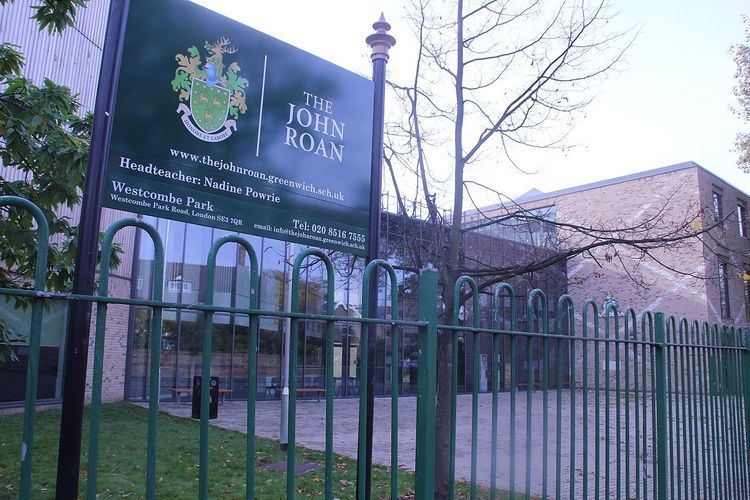Established 1677 (1677) Local authority Phone +44 20 8516 7555 Founder John Roan | Headteacher Vacant DfE number ???/4508 Number of students 1,147 Motto Honore et labore | |
 | ||
Type Voluntary controlled school Location Maze Hill
Greenwich
Greater London
SE3 7UD
England Address Maze Hill, London SE3 7UD, UK Profiles | ||
Class of 2012 the john roan school prom
The John Roan School is a secondary comprehensive school in Greenwich, Royal Borough of Greenwich, south-east London.
Contents
- Class of 2012 the john roan school prom
- Grammar schools
- Comprehensive
- Location
- Potential relocation
- Motto and house teams
- Notable former pupils
- Roan Boys Grammar School
- References
Grammar schools
The current school was originally two grammar schools. The boys' school was founded in 1677 and the girls' school in 1877 through a charitable endowment by John Roan, Yeoman of Harriers to King Charles I, who left a substantial amount in his Will:
"to bring up so many poor town-born children of Greenwich at school, that is to reading, writing, and cyphering, and each of them forty shillings per annum towards their clothing until each of them shall accomplish the age of fifteen years. The said poor children shall wear on their upper garment the cognisance or crest of me, John Roan."The stag's head badge – derived from John Roan's personal coat-of-arms – has been worn by Roan school children ever since. The first chairman of the governors of the school was Dr Thomas Plume, the vicar of Greenwich.
For much of the 18th century, the school was in the charge of the Herringham family who provided four successive headmasters from 1702 to 1785. The first headmaster of the boys' school from 1877, when it opened in Eastney Street, was Mr C.M. Ridger who held the post for 33 years. He was succeeded by Mr T.R.N. Crofts (1911–1919), Mr A.H. Hope (1919–1930), Mr W.J. Potter (1931–1938), Mr H.W. Gilbert (1938–1958) Mr W.L. Garstang (1959–1974) and Dr A J Taylor (1974 to turning comprehensive) all of whom made significant contributions to the grammar school. The Hope Memorial Camp at Braithwaite, near Keswick, Cumbria was established in Mr Hope's memory shortly after his death in 1930. The first headmistress of the Roan Girls' School was Miss M.M. Blackmore (until 1895) followed by Miss M.S. Walker (1895–1919), Miss M.K. Higgs (1919–1944), Miss M.E. Barnsdale (1944–1962), Miss M.S. Chamberlain (1962–1968) and Mrs M.J. Barber (1968–1980).
Comprehensive
It became a comprehensive in 1983, when Roan Grammar School for Boys and Roan School for Girls merged with Charlton Boys School.
Location
Since 1928 the school has been located east of Greenwich Park and south-east of Greenwich town centre, having moved there from Victorian purpose-built premises in Eastney Street (now Feathers Place).
The school is currently split over two campuses — Maze Hill, where the 1920s grade II listed neo-Georgian building (architects Percy Boothroyd Dannatt and Sir Banister Fletcher) stands, and Westcombe Park — named after the roads on which they lie (respectively Maze Hill and Westcombe Park Road).
The foundation stone of the Maze Hill buildings was laid by Sir George Hopwood Hume MP, local politician and chairman of London County Council, in 1926. The school had two opening ceremonies: one in 1927, by Herbert Fisher MP, and another following completion in 1928.
The John Roan Playing Fields are located approximately two miles (3 km) to the south, in Kidbrooke Park Road, west of Sutcliffe Park.
Potential relocation
During the first decade of the 21st century, the local council proposed to relocate the school to the Greenwich Peninsula, but, facing growing local opposition, it eventually scrapped the plans. Critics among parents and local residents argued that the current sites were good, and that money should instead be invested to refurbish the current sites. The proposed site was also near to an old gasometer, which would need to be dismantled at considerable cost for safety reasons, and alongside the busy A102 Blackwall Tunnel southern approach road.
With relocation ruled out, the Westcombe Park buildings were demolished in the summer of 2012 prior to construction of replacement buildings (completed in 2014), and the Maze Hill site will be refurbished and remodelled; both phases use funding originally granted when the school was due to move to the Peninsula.
Motto and house teams
The school's motto "With honour and hard work" (Latin: Honore et labore). The John Roan also has 4 house teams, named after people who have had quite a profound impact on history. They are: Seacole, Da Vinci, Darwin and Stopes, named after Mary Seacole, Leonardo da Vinci, Charles Darwin and Marie Stopes. Two tutor groups per year are in the same house team. There are also house leaders and competitions amongst the four houses.
